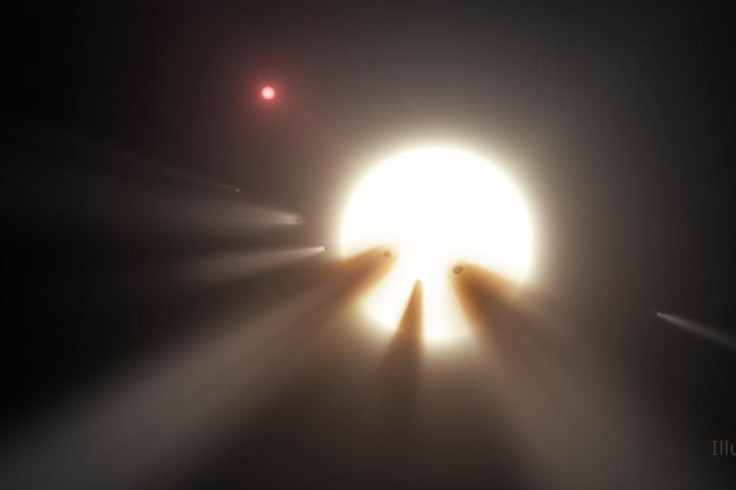‘Alien Megastructure’ Star Update: New Study Says KIC 8462852’s Bizarre Behavior Is Being Caused By A Planet-Star Collision

Remember KIC 8462852? More commonly known as “Tabby’s star,” or — in the less scientific circles — the one that has aliens building a massive Dyson sphere around it? For the last two years, the star’s bizarre behavior has confounded astronomers, who have invoked several ideas — a hypothesis involving a gigantic “alien megastructure” being proffered only half in jest — in their attempt at an explanation.
Now, in a study currently undergoing peer review, researchers from Columbia University and the University of California, Berkeley, have put forward another explanation — one they say explains not only the erratic dips in the star’s light, but also the long-term gradual dimming in its luminosity.
According to the researchers, the star is acting the way it is because it devoured an entire planet sometime in its past, and is only now returning to its natural state.
Before we delve into the findings of the latest study, here’s a lowdown of what we know about Tabby’s star so far.
The star, which has been informally named after the Yale University astronomer Tabetha Boyajian, who first noticed that the object was not behaving as it should — is located roughly 1,400 light-years from Earth between the constellations Cygnus and Lyra. Based on observations conducted using NASA’s Kepler Space Telescope between 2009 and 2013, a team led by Boyajian witnessed two unusual incidents, one each in 2011 and 2013, when the star's light dimmed in dramatic, never-before-seen ways — in one case, dimming by up to 20 percent.
This massive dip in luminosity indicated that something had passed in front of the star. At the time, a swarm of comets was proposed as the most likely explanation.
However, since then, several studies have argued that it is highly unlikely that a swarm of cometary could have caused the massive dip in the star’s luminosity. Other independent searches, especially tailored to detect alien radio signals and laser pulses, also drew a blank — disappointing proponents of the more outlandish theories that sought to explain the star’s behavior as something caused by the presence of a Dyson sphere — around it.
The latest explanation — put forward by Columbia University’s Brian Metzger and Nicholas Stone, and UC Berkeley’s Ken Shen — involves a planetary body. According to the authors of the study, this body fell into the star sometime between 10 and 10,000 years ago, causing it to brighten dramatically.
“We estimated that if Tabby’s star were representative, something like 10 Jupiters would have to fall into a typical star over its lifetime, or maybe even more,” Metzger told New Scientist.
Alternatively, the spike in brightness may have been caused by several smaller objects falling into the star in quick succession.
“If the planet was Jupiter-sized, then the disruption would have taken place about 1,000 years ago in order to explain the rate of dimming observed today,” Metzger told Gizmodo. “On the other hand, if the object was the size of the Moon, then the brightening and dimming would have taken place about a decade ago.”
This hypothesis, the researchers say, could explain both the erratic dimming — caused by remnants of the planet and any moons it may have passing in front of the star — and the long-term dimming in light — which is being caused by the star returning to its normal luminosity after experiencing a brief flux.
Discussing this hypothesis in a recent blog post, Jason Wright, an astronomer from Penn State University, said that while it was “plausible” that the star’s dimming may be the result of the inspiral of a planetary body or bodies, there are several issues that still need to be worked out.
“Whatever the explanation for Boyajian’s Star, it’s got to be an unlikely one because it’s unique among 200,000+ stars Kepler has observed. But this scenario turns out to be really unlikely — like Kepler had all but zero chance of seeing such a thing happen,” Wright said. “The effects of these merging events don’t last very long, so you need to stare a long time to have any chance of catching it happen. You would need practically every F star to have planetary material ready to go on eccentric orbits and merge, and even then you need a lot of planetary material.”
Whatever the answer to this cosmic mystery, aliens are probably not part of it.
© Copyright IBTimes 2024. All rights reserved.






















